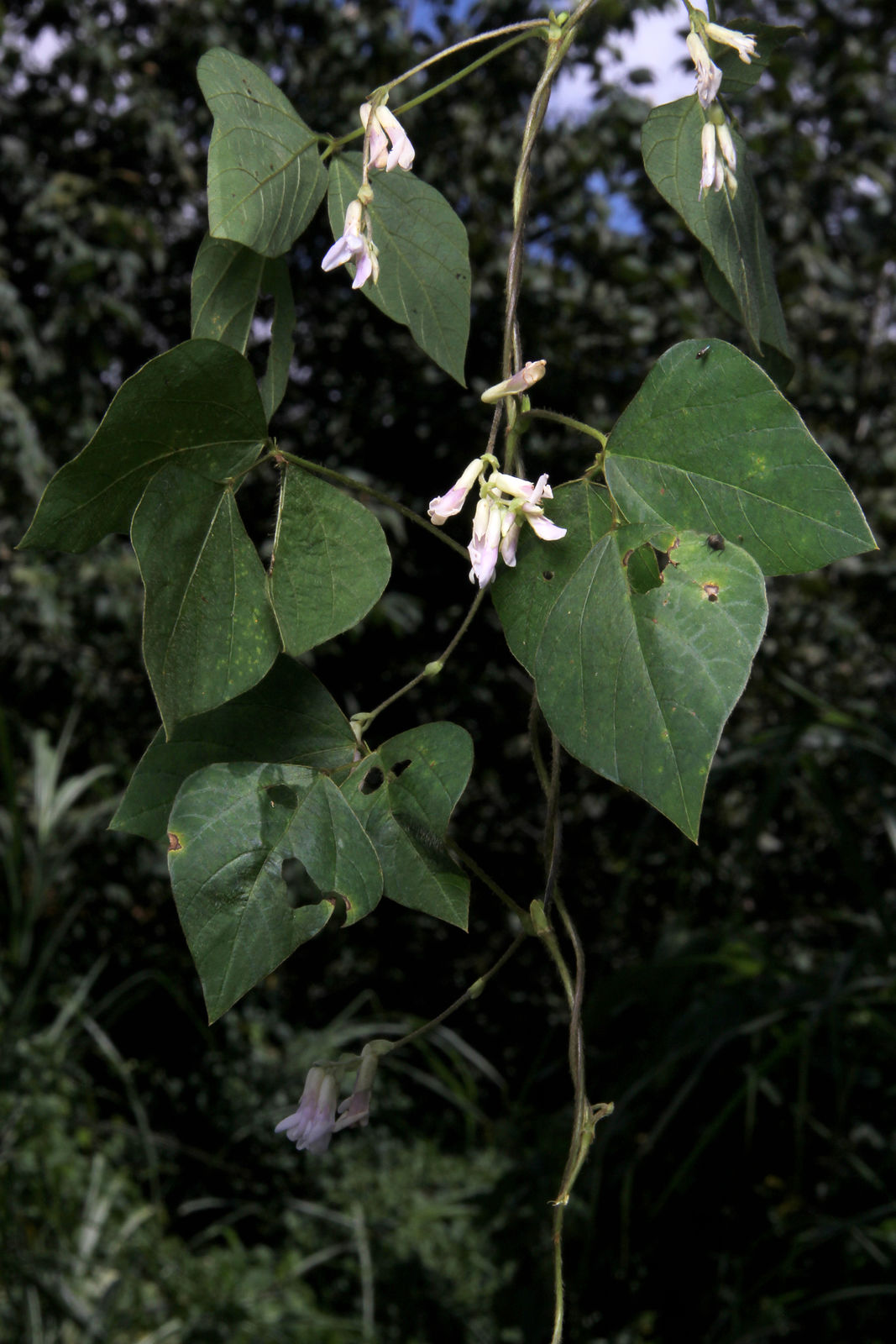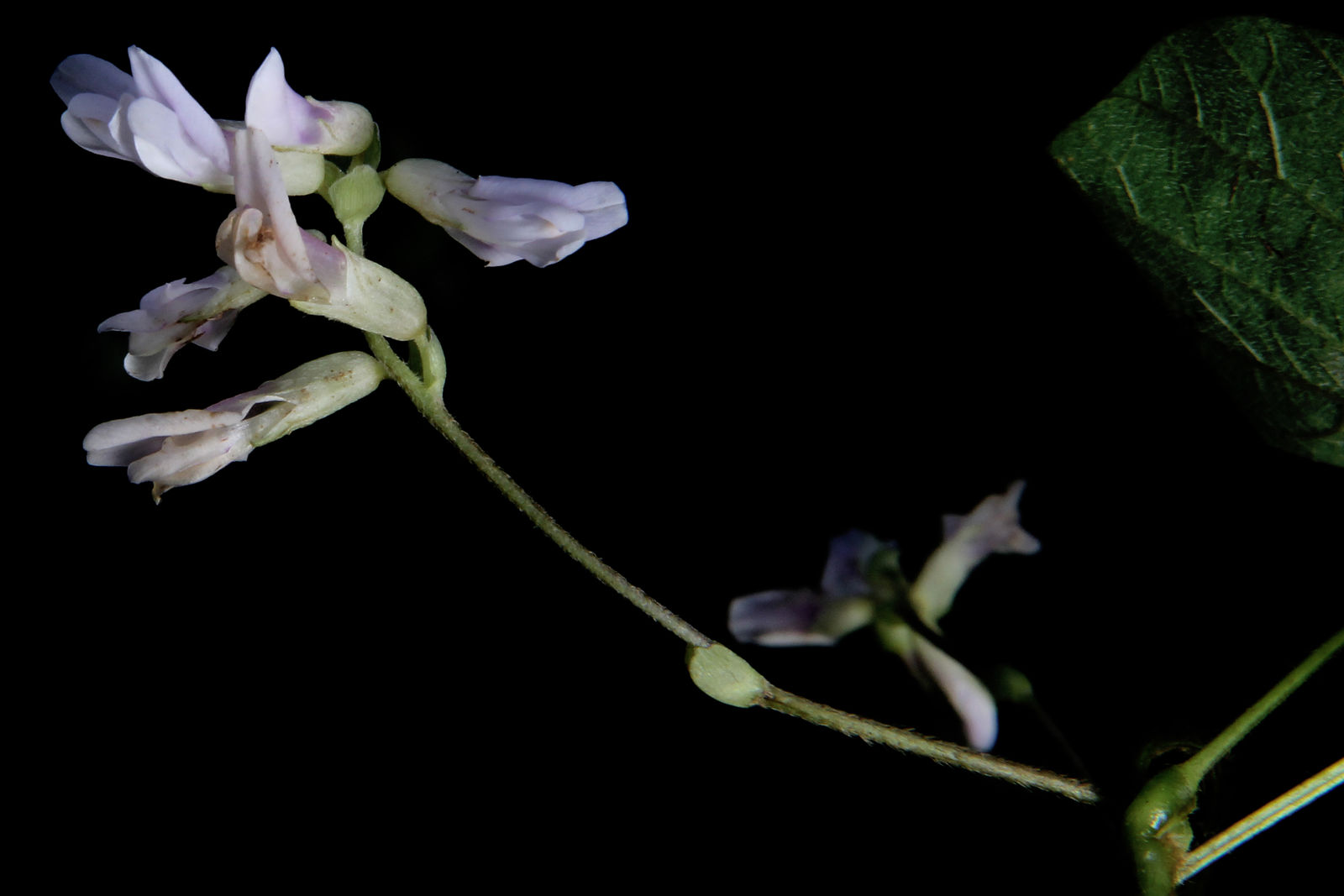Ground Bean
amphicarpaea bracteata
Also known as: ["Ground Bean","False Bean","Earth Bean"]
Overview
A climbing vine in the pea family, native to eastern North America, known for its unique habit of producing two types of flowers and seeds: aerial and subterranean.
Benefits & Perks
["edible fruits","wildlife attractant (bees, butterflies, birds)"]
Botanical Classification
| Phylum: | Magnoliophyta |
| Class: | Magnoliopsida |
| Order: | Fabales |
| Family: | Fabaceae |
| Genus: | Amphicarpaea |
| Botanical Name: | Amphicarpaea bracteata |
Plant Characteristics
Basic Information
- Category: Herbs & Weeds
- Suitable Location: woodland garden or shaded border
- Suitable For:
- Is Weed: No
- Allergenicity: low
Environmental Needs
- Climate: {"temperatureRange":"0–35°C"}
- Hardiness: {"zones":"4–8"}
- Misting: rarely required, only if ambient humidity is very low
- Drainage: Moderately well-draining; avoid waterlogged conditions.
- Soil Type: Rich, loamy soil with good organic matter; well-draining but moisture-retentive.
Maintenance Level
- Maintenance Level: moderate
- Toughness Level: moderate
- Pruning Frequency: As needed, typically every 6–12 months or after flowering.
- Pruning Intensity: Light to moderate; avoid heavy pruning unless necessary for health.
Care Details
Ideal Sunlight Coverage:
Partial shade to full shade; tolerates low light but prefers bright indirect light for 4–6 hours daily; adjust for seasonal light changes.
Sunlight Tolerance Tips:
Acclimate gradually to brighter light to avoid leaf burn; protect from direct sun; place in a shaded outdoor area or north-facing window indoors.
Care Requirements
Care Difficulty
moderatemoderate
Sunlight
partial shade to full shade
Avoid direct afternoon sun; rotate plant for even growth; use sheer curtains to filter intense light.
Watering
every 7–10 days during active growth, reduce in winter
Water deeply but infrequently; ensure proper drainage; adjust based on season and growth stage.
Soil
well-drained, humus-rich soil
pH: Slightly acidic to neutral (pH 6.0–7.0).
Avoid heavy clay soils; ensure consistent moisture without saturation; enrich with organic matter annually.
Temperature
Prefers cool to moderate temperatures (60–75°F or 15–24°C); can tolerate cooler conditions but avoid prolonged exposure below 50°F (10°C).
Keep away from heating/cooling vents; maintain consistent temperatures; monitor for signs of stress.
Fertilizing
every 4–6 weeks during growing season
Apply fertilizer after watering to prevent root burn; flush soil occasionally to prevent salt buildup; match fertilizer to plant's growth stage.
Propagation
Methods
Stem cuttings or division of rhizomes; stem cuttings are more common for home growers.
Step-by-Step Propagation Guide
- Take a 4–6 inch cutting with at least one node.
- Remove lower leaves.
- Dip in rooting hormone (optional).
- Plant in moist medium.
- Keep warm and humid.
Best Time: Spring or early summer when the plant is actively growing.
Environment
Warm, humid environment with indirect light; maintain consistent moisture.
Medium
Well-draining potting mix with perlite or sand; can also root in water initially.
Hormone
Optional but recommended for faster rooting.
Timeline
Roots may develop in 2–4 weeks; new growth in 6–8 weeks.
Tools Needed
Pruning shears, rooting hormone, small pots, well-draining soil mix, plastic wrap or propagator.
Quick Tips
Use healthy, non-flowering stems; maintain high humidity; avoid direct sunlight during rooting.
Pruning & Repotting
Pruning Guide
Method
Pinch back tips to encourage branching; trim leggy stems; remove yellow or dead foliage.
Pruning Plan
Prune to maintain shape, encourage bushier growth, and remove dead or diseased parts; focus on aesthetic and health benefits.
Tools
Clean, sharp pruning shears or scissors.
Checklist
Sterilize tools; prune during active growth; remove dead/diseased parts; shape as desired.
Repotting Guide
Best Season
Spring, before the active growing season begins.
Pot Size
One size larger pot (e.g., +2 inches in diameter); ensure good drainage.
Method
Gently remove plant; trim any circling roots; place in a slightly larger pot with fresh, well-draining soil; water thoroughly after repotting.
Suggestions
Repot every 2–3 years or when roots fill the pot; beneficial for rejuvenation and growth.
Checklist
Choose appropriate pot size; use fresh soil mix; handle roots carefully; water after repotting; place in appropriate light.
Advanced Care Tips
Watering Mastery
Watering Checklist
Check soil moisture before watering; water early in the day; ensure pots have drainage holes; avoid overwatering.
How to Apply Water Properly
Water at the base of the plant, ensuring moisture reaches the root zone without wetting foliage; water until it drains from the bottom, then allow the soil to dry slightly before the next watering.
Watering Schedule Tips
Water moderately during active growth (spring-fall), allowing soil to dry slightly between waterings; reduce frequency in winter to prevent root rot.
Soil Improvement
Add compost or peat moss for fertility; mix in perlite or sand for drainage; ensure aeration with organic matter.
Temperature Stress Management
Signs of Temperature Issues
Wilting, yellowing leaves, or stunted growth in extreme heat; leaf drop or browning in cold stress.
Cold Stress
Low temperatures slow growth and can cause root damage or leaf discoloration; prolonged cold may lead to dormancy or death.
Solution: Move to a warmer location; insulate pots; avoid cold drafts; protect from frost.
Hot Stress
Excessive heat can cause leaf scorch, wilting, or reduced flowering; may lead to dehydration.
Solution: Provide shade; increase humidity; water more frequently but avoid waterlogging; ensure good air circulation.
Fertilizing Guide
Fertilizing Checklist
Use diluted fertilizer; apply during active growth; avoid winter feeding; flush soil periodically.
Fertilizing Method
Use a balanced, water-soluble fertilizer diluted to half strength; fertilize monthly during spring and summer; avoid feeding in fall and winter.
Common Problems & Solutions
Toxicity Warning
Cats
Non-toxicAmphicarpaea bracteata is not toxic to cats. The plant does not pose a significant risk to felines if ingested.
⚡ Toxic If:
if eaten
Dogs
Non-toxicThere are no known toxic effects of Amphicarpaea bracteata on dogs. The plant is not considered harmful when ingested by canines.
⚡ Toxic If:
if eaten
Humans
Non-toxicAmphicarpaea bracteata, commonly known as ground bean or hog peanut, is not considered toxic to humans. The plant is occasionally consumed as a food source, particularly the subterranean seeds, which are edible and nutritious.
⚡ Toxic If:
if eaten
Frequently Asked Questions
Q: Is the Ground Bean plant edible?
A: Yes, the subterranean seeds of Amphicarpaea bracteata are edible and were historically used as a food source by Native Americans.
Q: How does this plant differ from other legumes?
A: It is unique in producing both aerial flowers (which produce typical legume pods) and subterranean flowers (which produce edible, peanut-like seeds underground).
Q: Does this plant require a trellis?
A: Yes, as a climbing vine, Amphicarpaea bracteata benefits from support structures to grow vertically.
Quick Reference
| Family: | Fabaceae |
| Care: | moderate |
| Light: | partial shade to full shade |
| Water: | every 7–10 days during activ |
Get Expert Care Tips
Download the Plantious app for personalized care reminders and plant identification!
Google Play App Store








